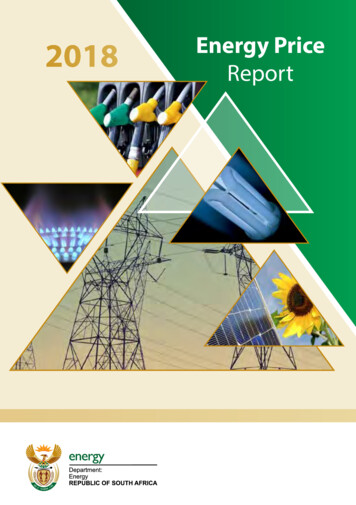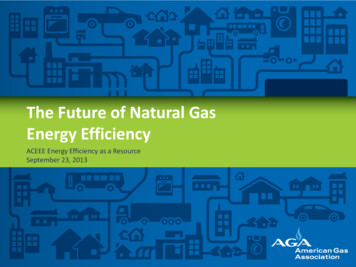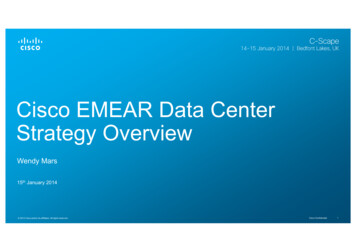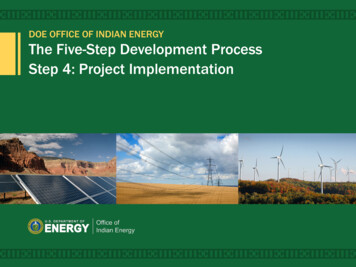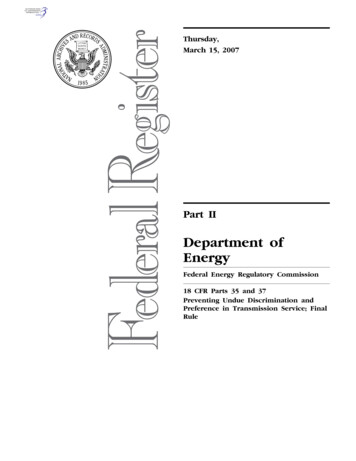
Transcription
Thursday,March 15, 2007Part IIDepartment ofEnergyFederal Energy Regulatory Commissionsroberts on PROD1PC70 with RULES18 CFR Parts 35 and 37Preventing Undue Discrimination andPreference in Transmission Service; FinalRuleVerDate Aug 31 200518:17 Mar 14, 2007Jkt 211001PO 00000Frm 00001Fmt 4717Sfmt 4717E:\FR\FM\15MRR2.SGM15MRR2
12266Federal Register / Vol. 72, No. 50 / Thursday, March 15, 2007 / Rules and RegulationsDEPARTMENT OF ENERGYFederal Energy RegulatoryCommission18 CFR Parts 35 and 37[Docket Nos. RM05–17–000 and RM05–25–000; Order No. 890]Preventing Undue Discrimination andPreference in Transmission ServiceIssued February 16, 2007.Federal Energy RegulatoryCommission, DOE.ACTION: Final rule.AGENCY:SUMMARY: The Federal EnergyRegulatory Commission is amending theregulations and the pro forma openaccess transmission tariff adopted inOrder Nos. 888 and 889 to ensure thattransmission services are provided on abasis that is just, reasonable and notunduly discriminatory or preferential.The final rule is designed to: Strengthenthe pro forma open-access transmissiontariff, or OATT, to ensure that itachieves its original purpose ofremedying undue discrimination;provide greater specificity to reduceopportunities for undue discriminationand facilitate the Commission’senforcement; and increase transparencyin the rules applicable to planning anduse of the transmission system.EFFECTIVE DATE: This rule will becomeeffective May 14, 2007.FOR FURTHER INFORMATION CONTACT:Daniel Hedberg (Technical Information),Office of Energy Markets and Reliability,Federal Energy Regulatory Commission,888 First Street, NE., Washington, DC20426, (202) 502–6243.W. Mason Emnett (Legal Information),Office of the General Counsel—EnergyMarkets, Federal Energy RegulatoryCommission, 888 First Street, NE.,Washington, DC 20426, (202) 502–6540.Kathleen Barrón (Legal Information),Office of the General Counsel—EnergyMarkets, Federal Energy RegulatoryCommission, 888 First Street, NE.,Washington, DC 20426, (202) 502–6461.SUPPLEMENTARY INFORMATION:ParagraphNos.sroberts on PROD1PC70 with RULESTable of ContentsI. Introduction .II. Background .A. Historical Antecedent .B. Order No. 888 and Subsequent Reforms .C. EPAct 2005 and Recent Developments .III. Need for Reform of Order No. 888 .A. Opportunities for Undue Discrimination Continue to Exist .B. Lack of Transparency Undermines Confidence in Open Access and Impedes Enforcement of Open Access RequirementsC. Congestion and Inadequate Infrastructure Development Impede Customers’ Use of the Grid .D. A Consistent Method of Measuring ATC Is Needed .E. Discriminatory Pricing of Imbalances .F. Redispatch/Conditional Firm .G. EPAct 2005 Emphasized Certain Policies and Priorities for the Commission .IV. Summary, Scope and Applicability of the Final Rule .A. Summary of Reforms .B. Core Elements of Order No. 888 That Are Retained .1. Federal/State Jurisdiction .2. Native Load Protection .3. The Types of Transmission Services Offered .4. Functional Unbundling .C. Applicability of the Final Rule .1. Non-ISO/RTO Public Utility Transmission Providers .2. ISO and RTO Public Utility Transmission Providers and Transmission Owner Members of ISOs and RTOs .3. Non-Public Utility Transmission Providers/Reciprocity .V. Reforms of the OATT .A. Consistency and Transparency of ATC Calculations .B. Coordinated, Open and Transparent Planning .C. Transmission Pricing .1. General .2. Energy and Generation Imbalances .3. Credits for Network Customers .4. Capacity Reassignment .5. ‘‘Operational’’ Penalties .a. Unreserved Use Penalties .b. Distribution of Operational Penalties .c. Applicability of Operational Penalties Proposal to RTOs and Other Independent or Non-Profit Entities .6. ‘‘Higher of’’ Pricing Policy .7. Other Ancillary Services .D. Non-Rate Terms and Conditions .1. Modifications to Long-Term Firm Point-to-Point Service .a. Planning Redispatch and Conditional Firm Options .b. Proposals for Transparent Redispatch .c. Other Requested Service Modifications .2. Hourly Firm Service .3. Rollover Rights .4. Modification of Receipt or Delivery Points .5. Acquisition of Transmission Service .a. Processing of Service Requests .b. Reservation Priority .6. Designation of Network Resources .a. Qualification as a Network Resource .VerDate Aug 31 200518:17 Mar 14, 2007Jkt 211001PO 00000Frm 00002Fmt 4701Sfmt 812961296139414321432
Federal Register / Vol. 72, No. 50 / Thursday, March 15, 2007 / Rules and RegulationsParagraphNos.Table of Contentsb. Documentation for Network Resources .c. Undesignation of Network Resources .7. Clarifications Related to Network Service .a. Secondary Network Service .b. Behind the Meter Generation .8. Transmission Curtailments .9. Standardization of Rules and Practices .a. Business Practices .b. Liability and Indemnification .10. OATT Definitions .E. Enforcement .1. General Policy .2. Civil Penalties .VI. Information Collection Statement .VII. Environmental Analysis .VIII. Regulatory Flexibility Act Analysis .IX. Document Availability .X. Effective Date and Congressional Notification .Appendix A: Summary of Compliance Filing RequirementsAppendix B: Commenting Party AcronymsAppendix C: Pro Forma Open Access Transmission TariffBefore Commissioners: Joseph T.Kelliher, Chairman; Suedeen G.Kelly, Marc Spitzer, Philip D.Moeller, and Jon Wellinghoff.I. Introductionsroberts on PROD1PC70 with RULES1. This Final Rule addresses andremedies opportunities for unduediscrimination under the pro formaOpen Access Transmission Tariff(OATT) adopted in 1996 by Order No.888.1 This landmark rulemakingfostered greater competition inwholesale power markets by reducingbarriers to entry in the provision oftransmission service. In the ten yearssince Order No. 888, however, theCommission has found that the OATTcontains flaws that undermine realizingits core objective of remedying unduediscrimination. In the Notice ofProposed Rulemaking (NOPR) issued onMay 19, 2006, the Commissionproposed to remedy those flaws.2 Afterreceiving approximately 6,500 pages ofcomments from close to 300 parties, wenow take final action. We highlightbelow the most critical reforms beingadopted today.1 Promoting Wholesale Competition ThroughOpen Access Non-discriminatory TransmissionServices by Public Utilities; Recovery of StrandedCosts by Public Utilities and Transmitting Utilities,Order No. 888, 61 FR 21540 (May 10, 1996), FERCStats. & Regs. § 31,036 (1996), order on reh’g, OrderNo. 888–A, 62 FR 12274 (Mar. 14, 1997), FERCStats. & Regs. § 31,048 (1997), order on reh’g, OrderNo. 888–B, 81 FERC § 61,248 (1997), order on reh’g,Order No. 888–C, 82 FERC § 61,046 (1998), aff’d inrelevant part sub nom. Transmission Access PolicyStudy Group v. FERC, 225 F.3d 667 (D.C. Cir. 2000)(TAPS v. FERC), aff’d sub nom. New York v. FERC,535 U.S. 1 (2002).2 Preventing Undue Discrimination andPreference in Transmission Service, Notice ofProposed Rulemaking, 71 FR 32,636 (Jun. 6, 2006),FERC Stats. & Regs. § 32,603 (2006).VerDate Aug 31 200518:17 Mar 14, 2007Jkt 2110012. First, the Final Rule will increasenondiscriminatory access to the grid byeliminating the wide discretion thattransmission providers currently havein calculating available transfercapability (ATC).3 The calculation ofATC is one of the most critical functionsunder the OATT because it determineswhether transmission customers canaccess alternative power supplies.Despite this, the existing OATT does notprescribe how ATC should be calculatedbecause the Commission sought to relyon voluntary efforts by the industry todevelop consistent methods of ATCcalculation. This voluntary industryeffort has not proven successful. TheCommission therefore acts today torequire public utilities, working throughthe North American Electric ReliabilityCorporation (NERC), to developconsistent methodologies for ATCcalculation and to publish thosemethodologies to increase transparency.This important reform will eliminate thewide discretion that exists today incalculating ATC and ensure thatcustomers are treated fairly in seekingalternative power supplies.3. Second, the Final Rule willincrease the ability of customers toaccess new generating resources andpromote efficient utilization oftransmission by requiring an open,transparent, and coordinatedtransmission planning process.Transmission planning is a critical3 The Commission used the term ‘‘AvailableTransmission Capability’’ in Order No. 888 todescribe the amount of additional capabilityavailable in the transmission network toaccommodate additional requests for transmissionservices. To be consistent with the term generallyaccepted throughout the industry, the Commissionrevises the pro forma OATT to adopt the term‘‘Available Transfer Capability.’’PO 00000Frm 00003Fmt 4701Sfmt 7141715172417521758175917601763function under the pro forma OATTbecause it is the means by whichcustomers consider and access newsources of energy and have anopportunity to explore the feasibility ofnon-transmission alternatives. Despitethis, the existing pro forma OATTprovides limited guidance regardinghow transmission customers are treatedin the planning process and providesthem very little information on howtransmission plans are developed. Thesedeficiencies are serious, given thesubstantial need for new infrastructurein this Nation.4 We act today to remedythese deficiencies by requiringtransmission providers to open theirtransmission planning process tocustomers, coordinate with customersregarding future system plans, and sharenecessary planning information withcustomers.4. Third, the Final Rule will alsoincrease the efficient utilization of4 Congress placed special emphasis on thedevelopment of transmission infrastructure,including the consideration of advancedtransmission technologies, in the Energy Policy Actof 2005 (EPAct 2005). See Pub. L. 109–58, 119 Stat.594 (to be codified in scattered titles of the U.S.C.).The Commission has taken steps to implement thatgoal in numerous contexts, including recentrulemaking proceedings that address the promotionof transmission investment through pricing reformand the siting of certain transmission facilities. SeePromoting Transmission Investment throughPricing Reform, Order No. 679, 71 FR 43294 (Jul.31, 2006), FERC Stats. & Regs. § 31,222 (2006), orderon reh’g, Order No. 679–A, 72 FR 1152 (Jan. 10,2007), FERC Stats. & Regs. § 31,236 (2007), reh’gpending; Regulations for Filing Applications forPermits to Site Interstate Electric TransmissionFacilities, Order No. 689, 71 FR 69440 (Dec. 1,2006), FERC Stats. & Regs. § 31,234 (2006), reh’gpending. As discussed herein, several actions takenin this Final Rule also relate to the need forinvestments in transmission infrastructure and areconsistent with the Commission’s responsibilitiesunder EPAct 2005.E:\FR\FM\15MRR2.SGM15MRR2
sroberts on PROD1PC70 with RULES12268Federal Register / Vol. 72, No. 50 / Thursday, March 15, 2007 / Rules and Regulationstransmission by eliminating artificialbarriers to use of the grid. The existingpro forma OATT allows a transmissionprovider to deny a request for long-termpoint-to-point service if the requestcannot be satisfied in only one hour ofthe requested term. This practicediscourages the efficient use of theexisting grid and precludes access toalternative power supplies. We reformthis practice by requiring that aconditional firm option be offered tocustomers seeking long-term point-topoint service, i.e., conditional firmservice. We also modify the redispatchobligations of transmission providers toincrease the efficient utilization of thegrid, while also ensuring that reliabilityto native load customers is maintained.5. Fourth, by adopting these and otherreforms, the Final Rule facilitates theuse of clean energy resources such aswind power. Conditional firm service isparticularly important to wind resourcesthat can provide significant economicand environmental value even ifcurtailed under limited circumstances.Open and coordinated transmissionplanning will enhance the ability ofcustomers to access clean energyresources as part of their future resourceportfolio. The Final Rule also benefitsclean energy resources by reformingenergy and generator imbalance charges.These reforms are particularly importantto intermittent resources such as windpower because these resources havelimited ability to control their outputand, hence, must be assured thatimbalance charges are no more thanrequired to provide appropriateincentives for prudent behavior.6. Fifth, the Final Rule will strengthencompliance and enforcement efforts. Weare increasing the transparency of proforma OATT administration, therebyincreasing the ability of customers andour Office of Enforcement to detectundue discrimination. We are adoptingoperational penalties for clear violationsof an OATT, thereby enhancingcompliance while also reducing theburdens on our Office of Enforcement.We are also increasing the clarity ofmany other OATT requirements,thereby facilitating compliance bytransmission providers with ourregulations. This Final Rule thus reflectsthe close integration of our Office ofEnforcement into policy development atthe Commission. Several of the reformswe adopt today are informed by ourexperience with OATT administrationthrough oversight, audits, andinvestigations performed by the Officeof Enforcement.7. Finally, we modify and improveseveral provisions of the pro formaOATT using our experience over theVerDate Aug 31 200518:17 Mar 14, 2007Jkt 211001past ten years and clarify others thathave proven ambiguous. For example,we reform our rollover rights policy toensure that the rights and obligations ofrollover customers are consistent withthe resulting obligations of transmissionproviders to plan and upgrade thesystem to accommodate rollovers. Weremove the price cap on reassignedcapacity because it is not necessary toremedy market power and doing so willotherwise increase the efficient use ofexisting capacity. We increase theefficient use of existing capacity byproviding a priority to certain ‘‘preconfirmed’’ requests for service. Weincrease certainty by providing greaterclarity regarding the wholesale contractsthat qualify as network resources. Wealso adopt numerous clarifications thatshould assist transmission providersand customers in implementing andusing the pro forma OATT8. Our actions in this proceeding havebeen informed to a great extent by thecomments received in response to ournotices of inquiry in the abovecaptioned dockets and the subsequentNOPR.5 We appreciate the time andthoughtfulness of all sectors of theindustry in preparing comments. Wehave found them very informative anduseful in reaching our decisions in thisFinal Rule.II. BackgroundA. Historical Antecedent9. In the NOPR, the Commissionexplained the historical background thatled up to the issuance of Order No. 888,and the initiation of this rulemakingproceeding. We repeat that history hereto place in context the actions we taketoday.10. In the first few decades afterenactment of the Federal Power Act(FPA) in 1935, the industry wascharacterized mostly by self-sufficient,vertically integrated electric utilities, inwhich generation, transmission, anddistribution facilities were owned by asingle entity and sold as part of abundled service to wholesale and retailcustomers. Most electric utilities builttheir own power plants andtransmission systems, entered intointerconnection and coordinationarrangements with neighboring utilities,and entered into long-term contracts tomake wholesale requirements sales(bundled sales of generation andtransmission) to municipal, cooperative,5 Preventing Undue Discrimination andPreference in Transmission Services, Notice ofInquiry, 112 FERC ¶ 61,299 (2005) (NOI);Information Requirements for Available TransferCapability, Notice of Inquiry, 111 FERC ¶ 61,274(2005) (ATC NOI).PO 00000Frm 00004Fmt 4701Sfmt 4700and investor-owned utilities connectedto each utility’s transmission system.Each system covered a limited servicearea, which was defined by the retailfranchise decisions of State regulatoryagencies. This structure of separatesystems arose naturally primarily due tocost and the technological limitationson the distance over which electricitycould be transmitted.11. A number of statutory, economic,and technological developments in the1970s led to an increase in coordinatedoperations and competition. Amongthose was the passage of the PublicUtility Regulatory Policies Act of 1978(PURPA),6 which was designed tolessen dependence on foreign fossilfuels by encouraging the development ofalternative generation sources andimposing a mandatory purchaseobligation on utilities for generationfrom such sources. PURPA also enabledthe Commission to order wheeling ofelectricity under limitedcircumstances.7 The rapid expansionand performance of the independentpower industry following the enactmentof PURPA demonstrated that traditional,vertically integrated public utilitiesneed not be the only sources of reliablepower. During this period, the profile ofgeneration investment began to change,and a market for non-traditional powersupply beyond the purchases requiredby PURPA began to emerge. Theeconomic and technological changes inthe transmission and generation sectorshelped encourage many new entrants inthe generating markets that could sellelectric energy profitably with smallerscale technology at a lower price thanmany utilities selling from their existinggeneration facilities at rates reflectingcost. However, it became increasinglyclear that the potential consumerbenefits that could be derived fromthese technological advances could berealized only if more efficient generatingplants could obtain access to theregional transmission grids. Becausemany traditional vertically integratedutilities still did not provide openaccess to third parties and favored theirown generation if and when they6 Pub. L. 95–617, 92 Stat. 3117 (1978) (codifiedin U.S.C. titles 15, 16, 26, 30, 42, and 43).7 Section 211 of the FPA, 16 U.S.C. 824j. In earlieryears, a few customers were able to obtain accessas a result of litigation, beginning with the U.S.Supreme Court’s decision in Otter Tail PowerCompany v. United States, 410 U.S. 366 (1973).Additionally, some customers gained access byvirtue of Nuclear Regulatory Commission licenseconditions and voluntary preference powertransmission arrangements associated with Federalpower marketing agencies. See, e.g., ConsumersPower Co., 6 NRC 887, 1036–44 (1977); ToledoEdison Co., 10 NRC 265, 327–34 (1979); FloridaMunicipal Power Agency v. Florida Power and LightCo., 839 F. Supp. 1563 (M.D. Fla. 1993).E:\FR\FM\15MRR2.SGM15MRR2
Federal Register / Vol. 72, No. 50 / Thursday, March 15, 2007 / Rules and Regulationssroberts on PROD1PC70 with RULESprovided transmission access to thirdparties, access to cheaper, more efficientgeneration sources remained limited.12. The Commission encouraged thedevelopment of independent powerproducers (IPPs), as well as emergingpower marketers, by authorizing marketbased rates for their power sales on acase-by-case basis, and by encouragingmore widely available transmissionaccess on a case-by-case basis. Marketbased rates helped to developcompetitive bulk power markets byallowing generating utilities to movemore quickly and flexibly to takeadvantage of short-term or even longterm market opportunities than thoseutilities operating under traditionalcost-of-service tariffs. In approving thesemarket-based rates, the Commissionrequired that the seller and its affiliateslack market power or mitigate anymarket power that they may have had.8The major concern of the Commissionwas whether the seller or its affiliatescould limit competition and therebydrive up prices. A key inquiry becamewhether the seller or its affiliates ownedor controlled transmission facilities inthe relevant service area and therefore,by denying access or imposingdiscriminatory terms or conditions ontransmission service, could forecloseother generators from competing.Beginning in the late 1980s, in order tomitigate their market power to meet theCommission’s conditions, publicutilities seeking Commissionauthorization for blanket approval ofmarket-based rates for generationservices under section 205 of the FPAfiled ‘‘open access’’ transmission tariffsof general applicability.9 TheCommission also approved proposedmergers under section 203 of the FPAon the condition that the mergingcompanies remedy anticompetitiveeffects potentially caused by the mergerby filing ‘‘open access’’ tariffs. The earlytariffs submitted in market-based rateproceedings under section 205 andmerger proceedings under section 203did not, however, provide access to thetra
access transmission tariff adopted in Order Nos. 888 and 889 to ensure that transmission services are provided on a basis that is just, reasonable and not unduly discriminatory or preferential. The final rule is designed to: Strengthen the pro forma open-access transmission tariff, or OATT, to ensure that it achieves its original purpose of



